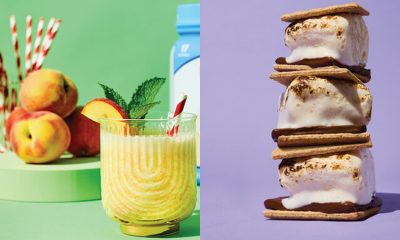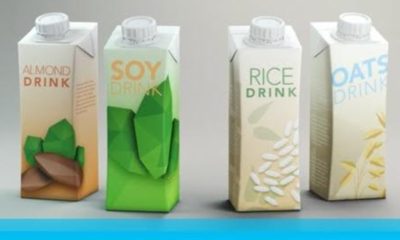Spotlight
Make marketing work for you
Strategies to grow your small business.

Many small business owners see their grand opening as the culmination of a lifelong dream of owning their own business. Indeed, it’s an important milestone, but it’s really just the beginning of a journey to build a brand that can attract and keep customers coming in the door.
Marketing is essential to the success of any business. It’s the way to tell people what products and services you offer, but more importantly, it’s an opportunity to tell your business’s story and convey why someone should choose to buy from you rather than a competitor.
Start with a plan
Just as you likely used a business plan to get your company off the ground, you’ll need a marketing plan to guide you in promoting your business. A marketing plan should include an analysis of your business’s strengths, weaknesses, opportunities and threats. It should also define your target audiences with as much detail as possible.
With this information, you can begin devising the strategies and tactics that will best answer the challenges and opportunities your business is likely to encounter. The scale of your plan will depend on the scope of your business and the resources you have available, but you should include a wide range of activities, from advertising and printed materials to events and social media. It’s also a good idea to build metrics into your plan, so you can assess how your ideas perform and make adjustments over time. Also remember to include a timeline to hold yourself accountable for executing the plan.
Define perceptions
Whether your business is brand new or you’re new to the idea of purposefully marketing your business, it’s important to know how you want people to perceive your brand and your company. Some of that information may be spelled out in your business plan, but for the purposes of marketing, it may be necessary to take it a step or two further to really tell your brand’s story. What do you want people to know? How should they feel when they interact with your company? Is there a reason your offering is superior to the alternatives? Ensure your marketing materials answer these types of questions clearly and concisely.
Make materials meaningful
For many small businesses, printed materials are the first impression customers and prospects have of your business. Printed materials can be any number of items, including direct mailers, business cards, newsletters, flyers, banners, posters and more.
Having professional, well-designed print items sends an important message about your business and your commitment to quality. Regardless of the format, all marketing materials should reflect your brand story. That is, the visual and linguistic ways you convey your brand.
Nearly all small business owners (90 percent) use printed materials in some aspect of their business, according to a survey conducted by The UPS Store. While marketing is the most common purpose, overall, small business owners use printed materials for a variety of other reasons such as internal documents, client documents and billing. Even those more functional pieces should consistently reflect your brand, the same as your external marketing materials.
Small business owners are often short on time and resources, but relying on a partner for print services can make things easier.
Marketing Solutions that Work
Try exploring these six print strategies that can help tell your small business brand story:
1. Flyers
Every store should have a grand opening, and a flyer is a great way to tell the community your business is ready to launch. Once your business is underway, you can promote specials and create brand awareness using updated flyers in the same style.
2. Business cards
Whether you are walking into a networking event or going about your daily routine, the right business card is a must to deliver a strong representation for your brand. In fact, a survey conducted by The UPS Store found that 70 percent of small business owners use business cards to market their businesses. Contact information is essential, but so is a quality design that lends credibility to your business.
3. Brochures
When you need more space to tell your story, brochures offer a low-pressure method to make a long-form pitch to customers. Having a sales associate promote your capabilities can be intimidating. Conversely, brochures provide you with an opportunity to show customers what your brand offers in a low-pressure way with full color and detail in a format they can carry out and refer to later.
4. Promotional Products
Promotional products can be fun, inexpensive ways to reach your customers. With branded items like T-shirts, bags, mugs or keychains, you can provide a functional product to your customer and raise brand awareness.
5. Postcards
With so many digital ad options available, today’s consumers receive less traditional mail, and that’s an opportunity to make your brand stand out. Postcards are a compact and cost-efficient way to announce a new product, the opening of a new location, a holiday sale or another important notice. Even if the recipient doesn’t immediately take action on the promotional message, postcards are also a good way to keep your brand in front of consumers and remind them of the products or services you can offer.
6. Presentations
A well-put together presentation can leave a lasting impression by adding impact and value to the information being shared. Presentations help reinforce your message and brand while keeping important information in one place for current and potential clients.
For more information, visit The UPS Store..
NewsMakers
Forget materialism, a simple life is happier: research
The commitment to simple living, or ‘voluntary simplicity’ as it is formally known, leads to wellbeing through providing more opportunities for personal interaction and social connection than conventional contexts of exchange, such as community gardens, sharing resources, and peer-to-peer lending platforms.

In an age where billionaires and conspicuous consumption are increasingly on display, new Otago-led research shows a simple life really is a happier life.
The study led by University of Otago – Ōtākou Whakaihu Waka Department of Marketing researchers has recently been published in the Journal of Macromarketing.
After setting out to understand the relationship between consumption and wellbeing, the researchers found people are happier and more satisfied when adopting sustainable lifestyles and resisting the temptations of consumerism.
They analysed data from a representative sample of more than 1000 New Zealanders, made up of 51 per cent men and 49 per cent women, with a median age of 45 and a median annual household income of $50,000.
They found the commitment to simple living, or ‘voluntary simplicity’ as it is formally known, leads to wellbeing through providing more opportunities for personal interaction and social connection than conventional contexts of exchange, such as community gardens, sharing resources, and peer-to-peer lending platforms.
Women are more likely to adopt a simple life than men, although more research is needed to understand why.
Co-author Associate Professor Leah Watkins says consumer culture promotes happiness as being typically associated with high levels of income and the capability it affords to acquire and accumulate material possessions.
“However, research is clear that attitudes to, and experiences of, materialistic approaches to life do not lead to increases in happiness or wellbeing. Nor do they lead to sustainable consumption necessary for planetary health.”
Between 2000 and 2019, global domestic material consumption increased by 66 per cent, tripling since the 1970s to reach 95.1 billion metric tons.
Growing consumer affluence and higher living standards have resulted in warnings of alarming trends of environmental degradation from human consumption.
This, coupled with global warming and post-pandemic health and financial anxieties, has led researchers and policymakers to call for a better understanding of the links between simple consumer lifestyles and wellbeing.
But co-author Professor Rob Aitken says this isn’t a case of just throwing out all your worldly possessions.
“It’s not directly the commitment to material simplicity that leads to wellbeing, but the psychological and emotional need fulfilment that derives from relationships, social connection, community involvement and a sense of living a purposeful and meaningful life.
“In a world where billionaire weddings are treated like state occasions and private yachts are the new status symbols, voluntary simplicity offers a quiet, powerful counter-narrative — one that values enough over excess, connection over consumption, and meaning over materialism.”
NewsMakers
Too much for some, just right for me – The truth about dating while plus-size
What is dating like for a plus-size woman? We don’t get the fairytale, the montage-worthy meet-cute in the bookstore, or the sweet swipe-rights with guys who use words like “connection” and “vibes.” What we get is a mixed bag of awkward encounters, accidental comedy, the occasional ghosting, and sometimes, someone who sees us as the whole damn package.
By: A Curvy Queen Who’s Seen It All
Let me be real with you: dating as a plus-size woman isn’t for the faint of heart. We don’t get the fairytale, the montage-worthy meet-cute in the bookstore, or the sweet swipe-rights with guys who use words like “connection” and “vibes.” What we get is a mixed bag of awkward encounters, accidental comedy, the occasional ghosting, and sometimes, someone who sees us as the whole damn package—not just the size of it.
I’m 33, a size 20, and I live in a city where everyone seems to be on a green juice cleanse or training for a marathon. My idea of a perfect day includes a cheese board, a crime documentary, and wearing something soft and oversized. I’ve been dating online for years now—Tinder, Bumble, Hinge, OkCupid, even a brief stint on Bigger Lover (don’t judge). I’ve had first dates that turned into second dates, and others that ended before the appetizer even came. But through it all, I’ve learned some hard truths about dating while plus-size.
The Fetish Factor
Let’s start with the obvious: there are guys out there who fetishize plus-size women. They love our bodies—but only in private. They send you those thirsty DMs like, “I’ve always had a thing for thick girls.”
I used to think that was a compliment. But it’s not, not when it’s the first thing they lead with, not when you realize they don’t care about your name, your career, or your sense of humor. Just your body.
I once met a guy off Tinder who spent our entire date talking about how much he “loved curves” and how he’d “never dated a big girl before.” He kept asking if I was into feederism (I had to Google it when I got home). I never heard from him again, which was fine—I didn’t need to be someone’s body experiment.
The Grateful Gambit
Then there’s this weird idea that plus-size women are supposed to be grateful for attention, as if someone choosing to date us is some charitable act. It’s subtle sometimes, but oh, it’s there.
I had a guy once tell me, over drinks, “I like girls who are a little bigger. They try harder, you know? They’re just more appreciative.”
I blinked. Tried harder at what? Breathing through my rage?
I wanted to ask him if he’d ever considered that maybe I’m not grateful to be on a date with him either. But instead, I left.
Online Dating – A Love-Hate Situation
The apps are their own beast. My profile is cute, funny, and unapologetically me. I mention that I love bookstores, brunch, and body positivity. I always include full-body pics, because I refuse to trick anyone—but I also refuse to hide.
And still, I get messages like: “You’re actually really pretty for a big girl.”
Sir, would you be willing to grow a personality for someone you really liked?
But it’s not all trash. I’ve had some sweet, genuine conversations and some fun dates. Not every guy is clueless. Some are kind, open, and emotionally intelligent.
The good, the bad, and the big truth
Dating while fat is exhausting. You have to weed through people who want to fix you, people who want to hide you, people who only want to sleep with you, and people who see you as their emotional support girlfriend.
But I’ve also never been more sure of who I am. I’ve learned to ask better questions, to take up space, and to walk away when someone doesn’t see my worth.
I’ve cried after bad dates, yes. I’ve called friends from bathroom stalls and whispered, “Why is this so hard?” But I’ve also danced in my kitchen with someone who made me feel radiant, kissed under streetlights, and been told, with complete sincerity, “You’re the most beautiful woman I’ve ever met.”
The truth is, being plus-size in the dating world means you see people for who they really are, faster. It forces you to develop an inner filter. You learn to walk away without guilt. And when you do meet someone who loves you not in spite of your size but as a part of your magic? It’s that much sweeter.
So to every plus-size woman out there who’s ever felt invisible, unworthy, or too much: you’re not too much. You might just be too real for the wrong person.
Keep showing up. Keep swiping. And keep loving yourself like you deserve to be loved—because trust me, you absolutely do.
NewsMakers
Research suggests drinking coffee may reduce the risk of frailty
Habitual coffee consumption of 4-6 cups and over* (with one cup measuring at 125ml) per day is associated with a reduced risk of frailty.

A new study published in the European Journal of Nutrition has suggested that habitual coffee consumption of 4-6 cups and over* (with one cup measuring at 125ml) per day is associated with a reduced risk of frailty.
The study, funded by the Institute for Scientific Information on Coffee (ISIC) is the first to analyze the relationship between coffee consumption and the underlying components of frailty.
Coffee consumption has previously been linked to reducing the risk of some of the natural symptoms of ageing, such as improving cognitive function2 and mitigating against inflammatory related diseases. This latest research adds to the growing knowledge base within this area, exploring the benefits of regular coffee consumption over an extended period of time.
For this study, researchers conducted a detailed analysis over a long seven-year follow-up period, surveying 1,161 adults aged 55+ years through the Longitudinal Aging Study Amsterdam (LASA).
The relationship between coffee consumption and the presence and incidence of frailty was investigated. Frailty status was evaluated using Fried’s five-component frailty phenotype4,which is defined by the presence of three or more of the following symptoms: weight loss, weakness, exhaustion, slow gait (walking) speed, and low physical activity.
The results of this study indicate that higher habitual coffee consumption is associated with lower overall odds of frailty. These findings can be considered alongside the European Food Safety Authority’s (EFSA) scientific opinion that up to 400mg of caffeine (3-5 cups of coffee) per day is a moderate and safe amount5.
The researchers explain that coffee’s effect on reducing frailty can partly be attributed to the role of antioxidants in coffee, which may help to reduce inflammation, sarcopenia (muscle loss), and prevention of muscle damage. Coffee may also help to improve regulating insulin sensitivity and glucose uptake in older people.
The study’s lead author, Margreet R. Olthof, Associate Professor at the Amsterdam Public Health Research Institute, Vrije Universiteit Amsterdam, commented: “Drinking coffee is a key part of many people’s daily routine, and as people age they are constantly looking for ways to maintain their health. Our findings highlight the possible beneficial association between daily coffee consumption and reduced risk of frailty in later life in the older population. Coffee consumption may thus enhance healthy aging, but it is important we also explore further dietary interventions, to ensure older adults can continue to live fulfilling lives.”
* Moderate coffee consumption can be defined as 3–5 cups per day, based on the European Food Safety Authority’s review of caffeine safety.
-

 NewsMakers3 weeks ago
NewsMakers3 weeks agoUnderstanding hypertrophic cardiomyopathy
-

 Pet Care3 weeks ago
Pet Care3 weeks agoBack-to-school season can be ruff on pets
-

 NewsMakers3 weeks ago
NewsMakers3 weeks agoPlant-based nutrient improves immune cells’ ability to fight cancer
-

 Home Care3 weeks ago
Home Care3 weeks agoExplore the benefits of a bathroom upgrade
-

 Nutrition3 weeks ago
Nutrition3 weeks agoProtein-packed sweet treats
-

 Nutrition3 weeks ago
Nutrition3 weeks agoPower your summer with 100% orange juice
-

 Destinations2 weeks ago
Destinations2 weeks agoFinding Neverland in London
-

 NewsMakers3 weeks ago
NewsMakers3 weeks agoForget materialism, a simple life is happier: research























